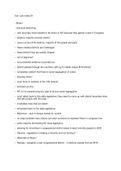Samenvatting
Summary Smart Organisation (CITM2.SMOR-01)
- Instelling
- NHTV (NHTV)
This summary contains all theory needed in order to pass the exam of SMOR. In my case I got a 9,7 at the BUAS/NHVT and in my exam I had to create a process flow chart, swimlane flow chart, pareto 80/20 analysis, root-cause analysis and a fishbone analysis.
[Meer zien]













